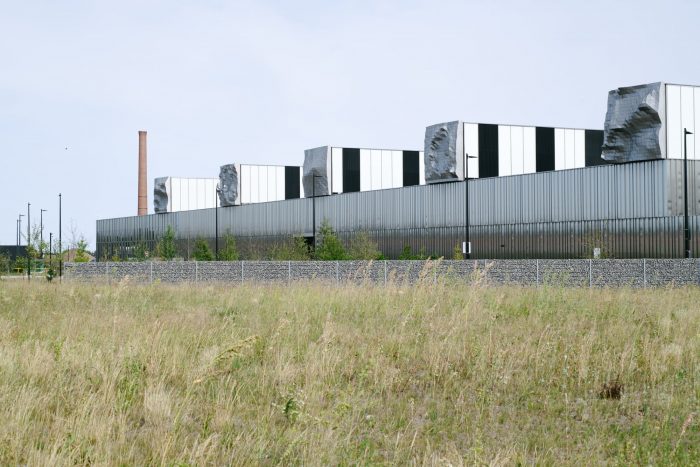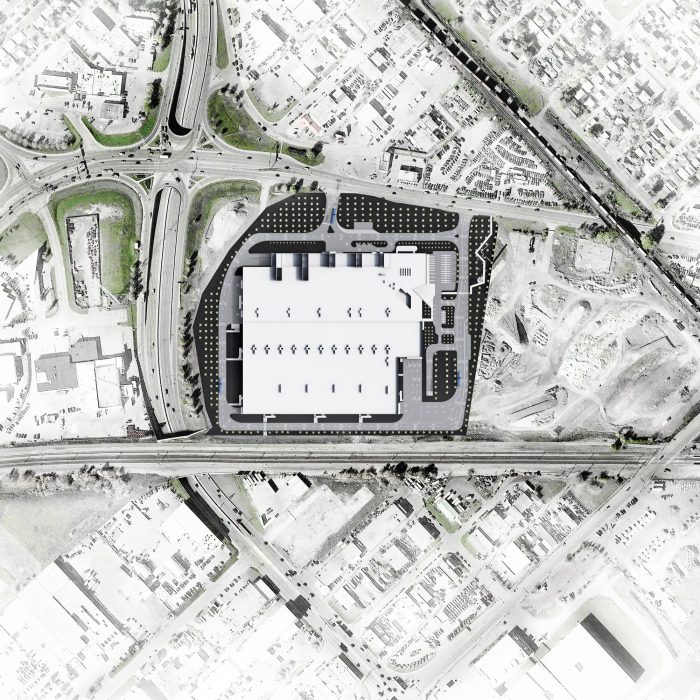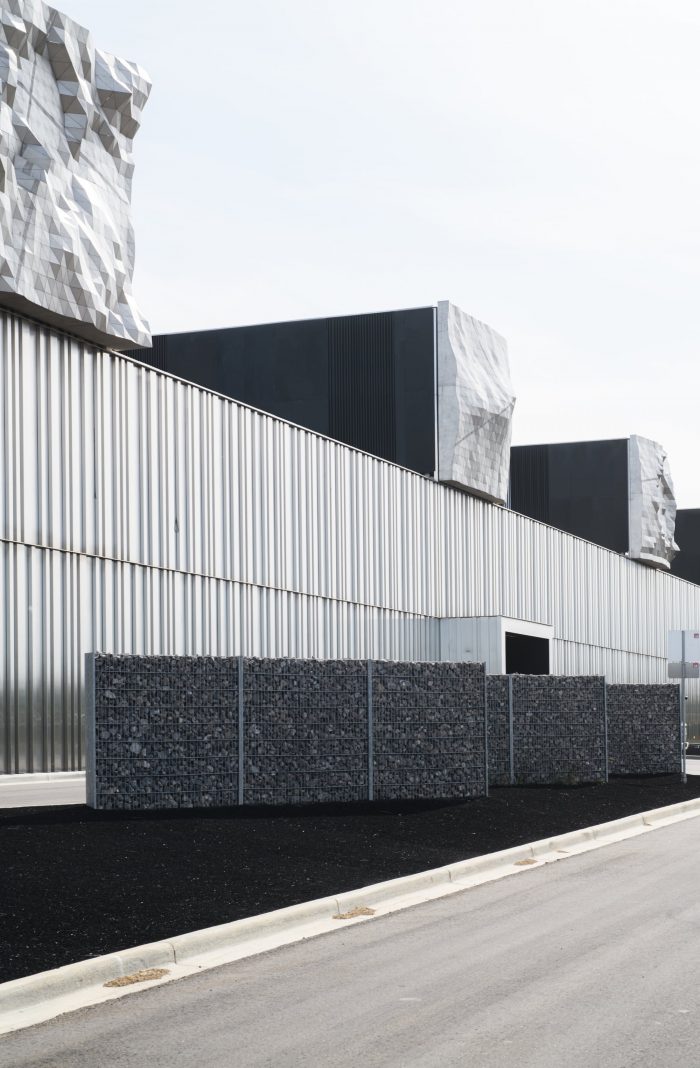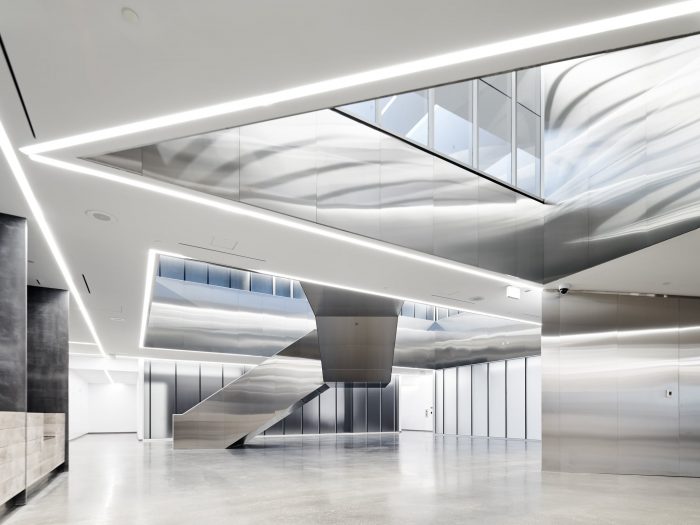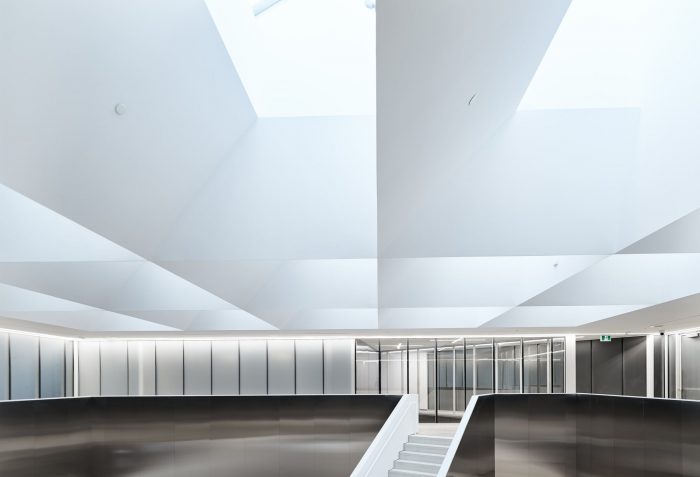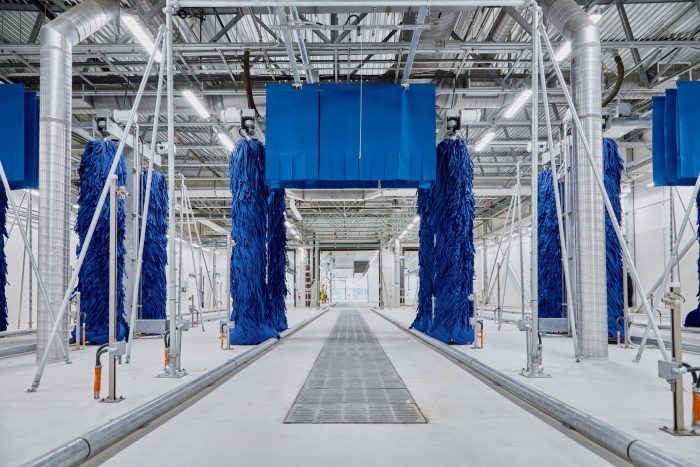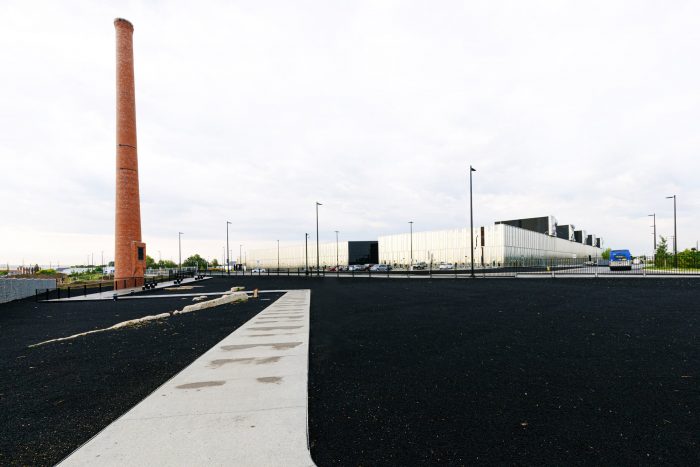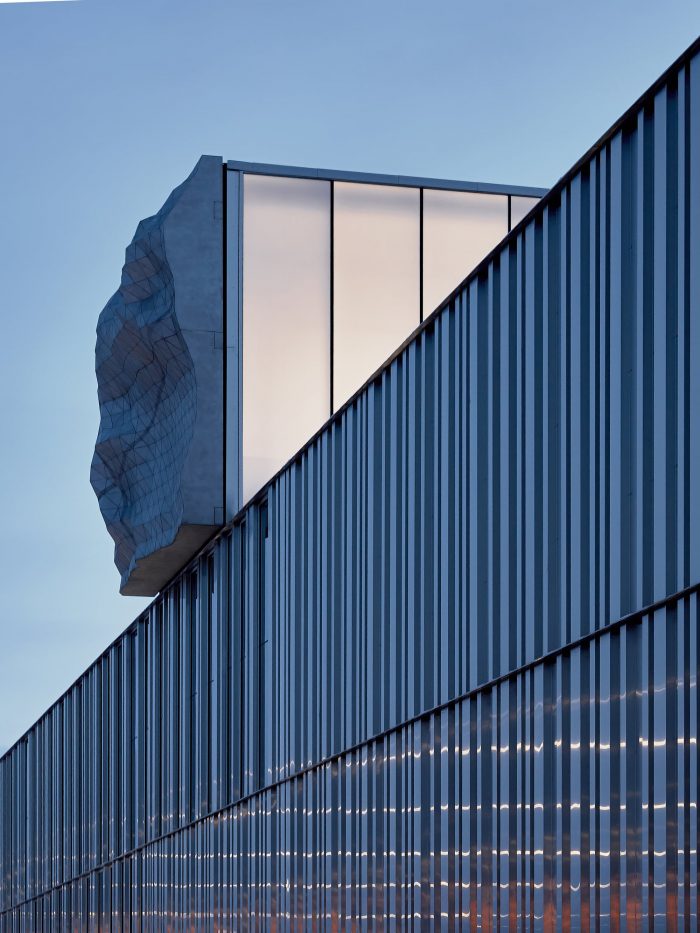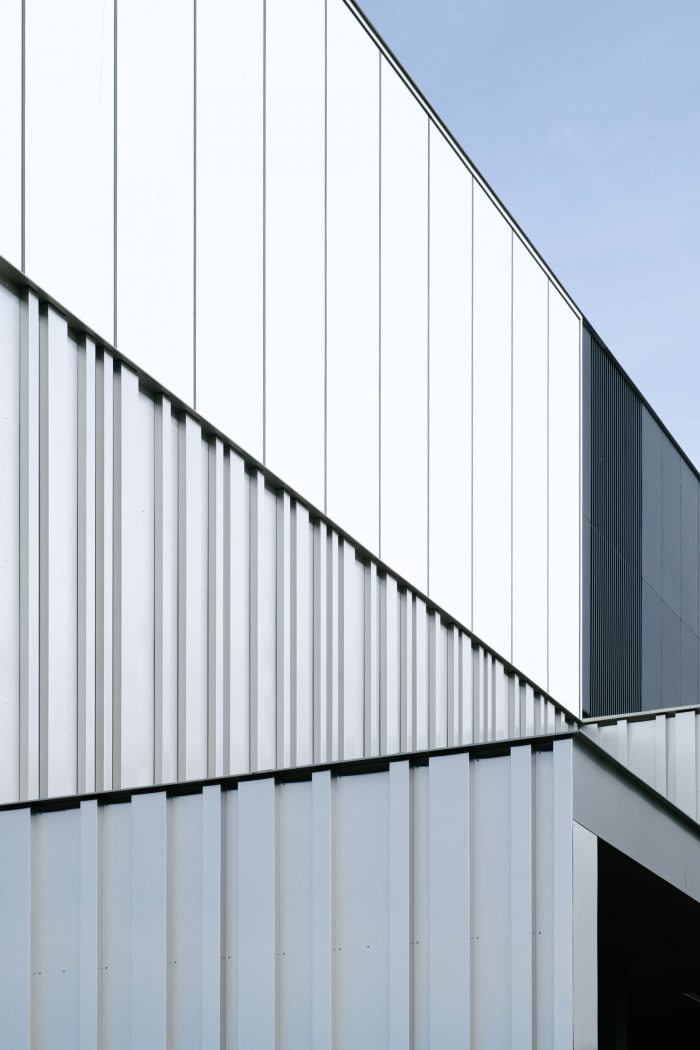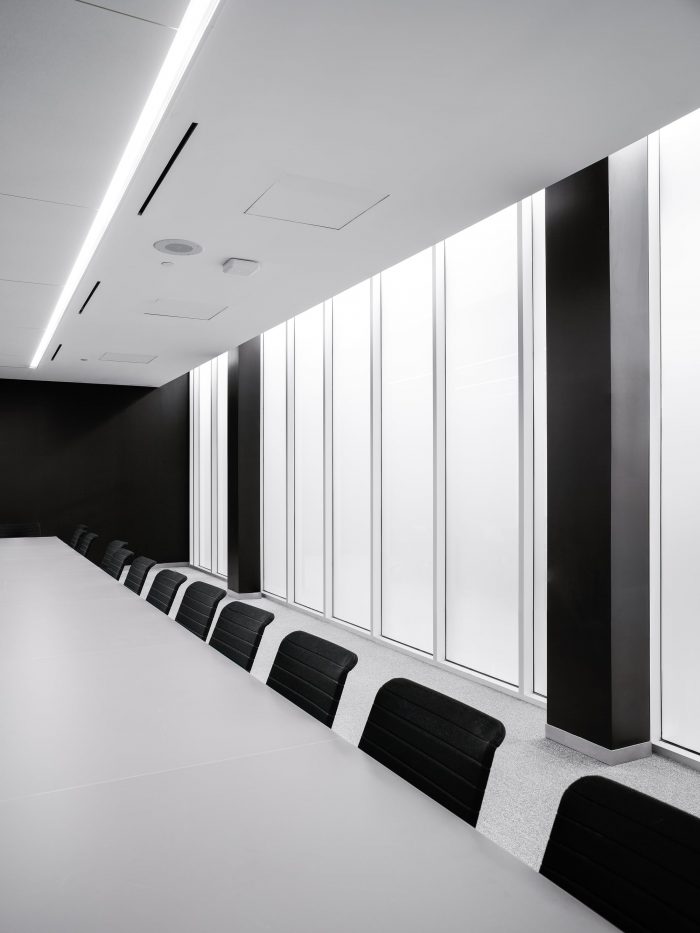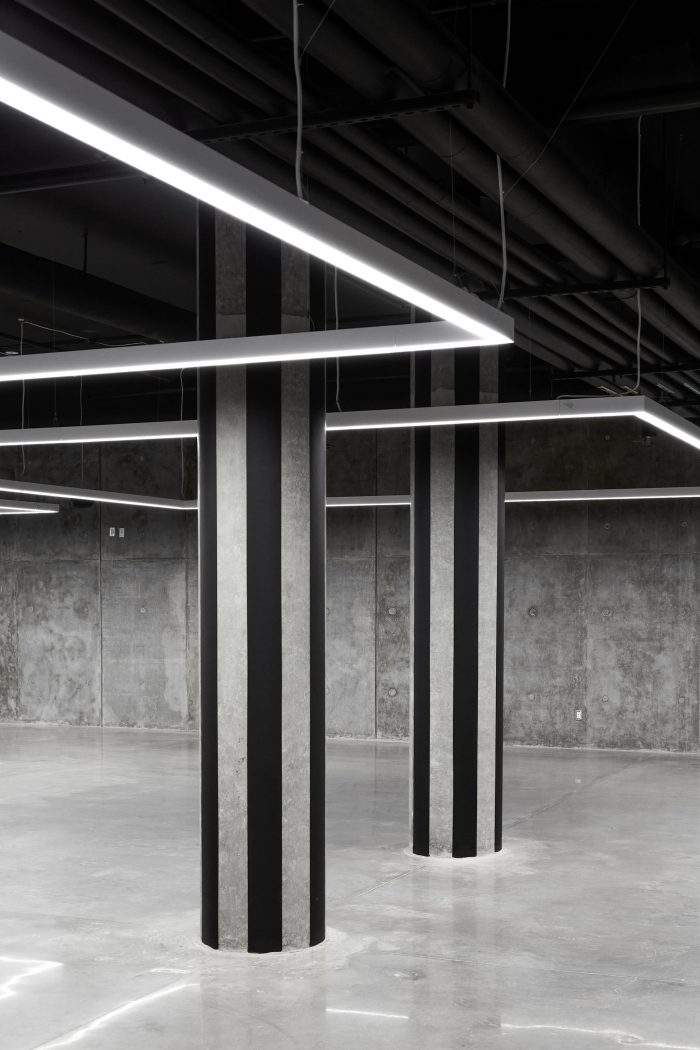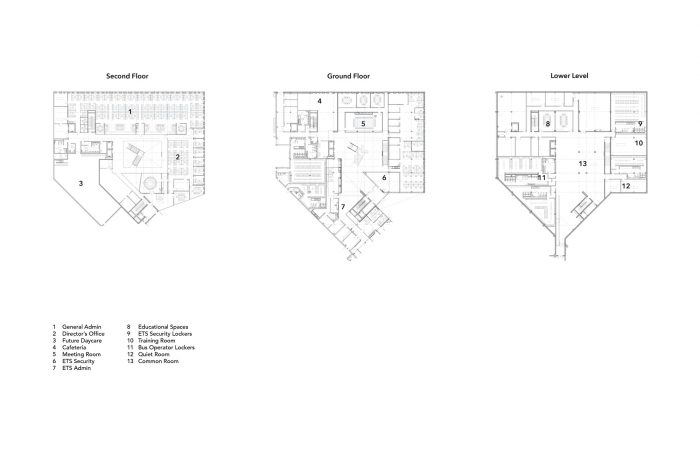埃德蒙顿的凯瑟琳-安德鲁斯公交车库(KATG)是一个市政公交车维修和储存设施,旨在为一个经常被忽视的建筑类型设定新的标准。KATG将苛刻的技术要求与简单严谨的建筑相协调,提升了一个传统的功利性建筑,并尊重其在一个不断增长、公平、可持续和有弹性的当代城市中的重要作用。功能上的高效和高度的可持续性与形式上的精致、历史保护和公共艺术相匹配,丰富了在这里工作的人和它所服务的广大社区的生活。
Edmonton’s Kathleen Andrews Transit Garage (KATG) is a municipal bus maintenance and storage facility designed to set new standards for an often-overlooked building type. Reconciling demanding technical requirements with simple and rigorous architecture, KATG elevates a conventionally utilitarian building and honors its important role within a growing, equitable, sustainable, and resilient contemporary city. Functional efficiency and high sustainability are matched by formal refinement, historic preservation, and public art, enriching both the lives of the people who work there and the wider community it serves.
KATG以埃德蒙顿第一位女公交司机的名字命名,容纳了300辆公交车和35个维修间,其中有三个车底清洗间,四个加油间和外部清洗间。一层的员工停车场在地面以下,这对当地的气温变化很大,从夏季高峰期的35°C到冬季的零下40°C,非常重要。这个繁忙的枢纽支持800名工人,包括公交车司机、维修、行政和交通安全人员,工作场所的亲密条件,无论是人还是机械,以及城市基础设施的规模。
Named after Edmonton’s first female bus driver, KATG houses 300 buses, and 35 maintenance bays with three undercarriage wash bays, four refuel bays and exterior wash bays. One level of employee parking is provided below grade — important in a locale whose temperatures can vary considerably from 35°C at the peak of summer to -40°C in winter. The busy hub supports 800 workers including bus drivers, maintenance, administration, and transit security staff with the intimate conditions of the workplace, whether human or mechanical, as well as the scale of urban infrastructure.
该建筑位于黄口小道(跨加拿大公路)和Fort路的交叉口,占地10英亩,与CP铁路轨道一致。1936年,该场地被加拿大包装商的屠宰场、畜牧场和肉类加工厂占据。由著名建筑师和教育家埃里克-阿瑟设计的加拿大包装公司工厂是
The building sits on a 10-acre site at the intersection of the Yellowhead Trail (the Trans-Canada Highway) and Fort Road which aligns with the CP Rail tracks. In 1936 the site was occupied by the Canada Packers’ abattoirs, stockyards, and meat processing plant. Designed by famed architect and educator, Eric Arthur, the Canada Packer’s factory was
在1980年代被拆除之前,它是加拿大功能性现代主义的一个主要例子,除了其50米高的烟囱。KATG通过保护烟囱和通过生态绿化、微气候阈值、生物水沟和密集的树木种植来修复这一遗产。此外,深思熟虑的景观设计,包括装满阿尔伯特河石的石笼网和粒状橡胶轮胎地表覆盖物,是将建筑和景观无缝结合的适当材料,同时也突出了地基和烟囱,以纪念那里以前存在的东西。
a prime example of functional Canadian modernism until it was demolished in the 1980s apart from its 50-meter-tall smokestack. KATG restores this legacy by conserving the smokestack and remediating the brownfield site through ecological greening, micro-climatic thresholds, bioswales, and dense tree planting. Moreover, thoughtful landscaping including gabion baskets filled with Albertan river stones and granulated rubber tire ground cover are appropriate materials to seamlessly integrate architecture and landscape, while also highlighting the foundations and the smokestack in memory of what existed there before.
KATG占地50,000平方米,是一个大工地上的大建筑。它的箱体形式被其连续的表面所打破,包裹在具有垂直波纹和不同宽度的高度绝缘的不锈钢板中。此外,沿着堡垒路,五个屋顶采光井包围着楼梯和机械系统,使建筑具有规模。这些雕塑由柏林艺术家Thorsten Goldberg设计,参考了世界上与埃德蒙顿纬度相同的山区的地形,讽刺的是世界上最平坦的地貌之一。这些不锈钢雕塑与建筑表面融为一体,为建筑的统一性增加了对比,无论是开车还是步行,都能刺激人们的好奇心和愉悦感。
At 50,000 m2 KATG is a big building on a big site. Its box-like form is broken down by its continuous surface, wrapped in highly insulated stainless-steel panels with vertical corrugations and variegated widths. Furthermore, along Fort Road, five rooftop light wells enclosing stairs and mechanical systems give the building scale. These are capped by sculptures by Berlin artist Thorsten Goldberg referencing the topography of mountainous regions around the world that are at the same latitude as Edmonton — ironically one of the world’s flattest landscapes. The stainless-steel sculptures synthesize with the building’s surface, adding contrast to the uniformity of the architecture, stimulating curiosity and delight whether encountered by car or by foot.
在内部,该建筑是强大的纯粹和单色的。员工从一个宽敞的下层聚集区进入,并通过一个雕塑般的楼梯到达一个日光充足的中央中庭。该设施的设计是为了优化公交车队的操纵、储存和维护,并促进蓝领和白领人员之间的重叠和交流,这是一种通过建筑体现的同事关系的政治姿态。
Inside, the building is powerfully pure and monochromatic. Employees enter through a generous lower-level congregating area, and up to a day-lit central atrium via a sculptural stair. The facility is designed to optimize the maneuvering, storage, and maintenance of the bus fleet and to promote overlap and exchange between blue- and white-collar personnel, in an almost political gesture of collegiality represented through architecture.
与传统的车库相比,公交车站的内部是明亮的白色,有助于促进健康和清洁。这种大胆而精确的建筑,在各种规模下执行,为埃德蒙顿的交通员工提供了尊严和尊重,并为其车队感到自豪。作为一个新的公民地标,该建筑也为市民提供了自豪感,并主张为这种对我们共同的城市经验如此重要的建筑类型制定更加雄心勃勃和严格的设计标准。
In contrast to the conventional garage, the bus station interiors are bright white, helping to facilitate both wellness and cleanliness. Such bold and precise architecture, executed at all scales, offers dignity and respect to Edmonton’s transit employees and pride in its fleet. As a new civic landmark, the building also provides pride of place for citizens and argues for more ambitious and exacting design standards for a building type that is so important to our shared urban experience.
交通站很少吸引设计师或公众的注意,尽管它们的功能对大多数社区的生活至关重要。KATG试图用一个新的公民地标来庆祝这些服务,并进一步提高埃德蒙顿作为一个进步城市的声誉。
Transit depots rarely attract attention from either designers or the public, despite their functions is critical to the life of most communities. KATG attempts to celebrate these services with a new civic landmark, and further Edmonton’s reputation as a progressive city.
Architects: gh3*
Area : 50000 m²
Year : 2021
Manufacturers : Omega Fence Systems, Sobotec, Canem Systems LTD, Collins Industries, Flynn, Gabion Wall Systems, Milltech Group, Softline Solutions
Structural Engineer : Morrison Hershfield
Mechanical Engineer : Morrison Hershfield
Main Contractor : Graham Construction
Design Team : Pat Hanson FRAIC, Raymond Chow RAIC, Louis Clavin, Byron White, Elise Shelley, Joel Di Giacomo, Jeffrey Deng, Bernard Jin
Artist : Thorsten Goldberg
City : Edmonton
Country : Canada



